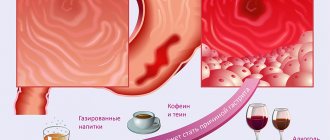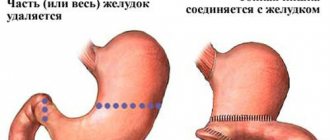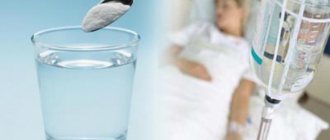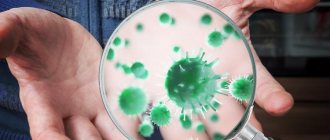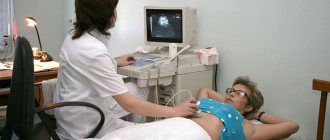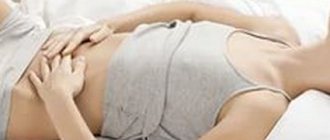Gastroduodenitis - what it is, symptoms and treatment
Gastroduodenitis (from the Latin gastroduodenitis) is a polyetiological disease of the gastrointestinal tract, in which the patient develops an inflammatory process in the pyloric zone of the stomach (lower part) and the mucous membrane of the duodenum. The pathological process is accompanied by a change in the structure of the tissues of the stomach and intestines and manifests itself in two forms: acute and chronic.
This disease is a form of chronic gastritis. Its formation begins in the pyloric (pyloric) part of the stomach in the form of an inflammatory process, which in medical practice is defined as gastritis. However, the disease takes on its final form only when the tissues of the duodenum are also involved in the pathological process (duodenitis develops).
What it is
Gastroduodenitis is an inflammation of the pyloric part of the stomach (the part that goes into the intestines) and duodenum.
In other words, it is a combination of gastritis and duodenitis. This disease is more severe than the pathologists mentioned separately. Accordingly, gastroduodenitis is less treatable. If the form of the disease is chronic, periods of remission (subsidence) are replaced by exacerbations. Chronic gastroduodenitis is characterized by a gradual loss of regenerative functions by cells. Over time, they die off, which leads to disruption of the secretory, motor and evacuation functions of the pyloric part of the stomach and duodenum¹.
There are no exact statistics regarding chronic gastroduodenitis. According to some sources, up to 30% of people suffer from the disease². Moreover, the pathology is often found among children - often inflammatory processes in the stomach and duodenum begin in childhood and adolescence. As a rule, the bacterium Helicobacter pylori is to blame.
Inflammation usually begins in the stomach and spreads lower into the duodenal tissue. Over time, metaplasia develops - the replacement of some functional cells of the mucous membrane with others. Then the already changed parts of the duodenal tissue are exposed to the acidic contents of the stomach (with gastroduodenitis, the acidity of the stomach usually increases), which only aggravates the inflammatory process.
Figure 1. Gastritis and gastroduodenitis. Image: Olek Remesz (wiki-pl: Orem, commons: Orem) / Wikipedia (CC BY-SA 2.5)
What features of anatomy and functioning connect the two organs?
The stomach comes into contact with the initial part of the small intestine in the pyloroantrum through the sphincter. The adjacent part of the duodenum is called the bulb, which is what we are talking about when dealing with duodenitis.
Food that enters the stomach remains for 6–10 hours. This time is required to completely process the contents with gastric juice and move them towards the intestines. In the antrum area there are the necessary glandular cells that produce hormone-like substances (gastrin, pepsin, histamine, acetylcholine).
They stimulate the production of gastric juice under the influence of endocrine and nervous regulation. The inhibitory effect is exerted reflexively by enterogastrines and hydrochloric acid entering the bulb (acid duodenal reflex). As a result, protein substances from food are broken down in the stomach into albumins and peptones.
Some substances are absorbed into the blood already at this stage. The importance of supporting the digestive process in the pyloroduodenal zone is indicated by the massive blood supply, established according to one principle - arteries on both sides. Such vascularization provides the possibility of compensation and replacement in case of thrombosis.
Moreover, in the area below the duodenal bulb, blood enters only from one side (through the vessels of the mesentery). To neutralize the acidic contents of the stomach in the border region of the intestine, it is necessary to reduce the concentration of hydrogen ions by 100 thousand times. In the upper part, the wall of the duodenum is strengthened by three layers of membranes (then only 2 remain).
Mucosal cells produce enterogastron, cholecystokinin, secretin, pancreozymin, enterocrinin, valkinin to counteract hydrochloric acid from gastric juice. In addition, enzymes from bile and pancreatic secretions enter the lower sections.
One of the reasons for digestive failure and gastroduodenitis in patients after gastric resection surgery (tumor, peptic ulcer) is the lack of necessary duodenal hormones
Every 20–26 seconds, due to the contraction of the muscular wall, a circular wave passes through the stomach (in an empty stomach after an hour and a half), promoting the bolus of food to the pylorus. The opening and closing of the canal is regulated by the obturator reflex. The signal comes from the duodenal bulb: if there is an acidic reaction there, the pylorus closes; if it is alkaline, it is open.
The normal throughput of the pylorus is about 3% of the stomach contents per minute. Any failure of a clear mutual connection affects the general process of digestion; gastroduodenitis affects other organs.
Causes
There are internal and external causes of chronic gastroduodenitis. External ones include:
- H. pylori infection. This is a spiral-shaped bacterium that can survive in the hydrochloric acid of the stomach. Helicobacter pylori infection is the main cause of inflammatory diseases of the stomach - gastritis, gastroduodenitis and peptic ulcers. Infection is also considered as a factor in the development of gastric cancer.
- Errors in nutrition. Food must be well chewed so that it enters the stomach in a mushy form. Large, rough bolus of food irritate the stomach lining, promoting inflammation. In addition, addiction to too spicy, hot or cold foods also increases the risk of inflammatory pathologies of the digestive tract.
- Excessive consumption of alcoholic beverages or strong coffee. Alcohol has an irritating effect on the mucous membrane, and coffee (especially drunk on an empty stomach) stimulates the production of hydrochloric acid.
- The action of certain chemicals. These include pesticides, acids, alkalis, heavy metals and others.
- Taking certain medications. Most often these are non-steroidal anti-inflammatory drugs (they cannot be taken for more than 3-5 days in a row) and antibiotics.
- Smoking. Smokers experience vascular spasm (including in the digestive tract), which contributes to the appearance of inflammation.
Internal causes of chronic gastroduodenitis:
- diseases of the liver and biliary tract;
- diseases of the endocrine system;
- inflammation of the pancreas (pancreatitis);
- cardiovascular and pulmonary diseases in which hypoxia is observed (oxygen starvation of tissues);
- hereditary predisposition;
- allergic and autoimmune diseases;
- renal failure, in which large amounts of toxic nitrogenous substances are released through the intestinal mucosa;
- disruption of mucus production in the stomach.
Stress and gastritis
It became known relatively recently that the lion's share of cases of gastritis occurs due to infection.
Barry Marshall and Robin Warren are scientists who have proven that gastritis and ulcers of the stomach and duodenum occur against the background of Helicobacter pylori infection. In 2005 they received the Nobel Prize for their discovery. Before this discovery, other theories regarding these diseases dominated the world. In particular, it was believed that the main cause of inflammatory pathologies of the stomach is stress. Stress can indeed be a factor that increases the symptoms of the disease. However, in a healthy person, stress cannot cause gastroduodenitis.
Symptoms of chronic gastroduodenitis
With chronic gastroduodenitis, the symptoms are varied. In most cases, patients are bothered by pain or discomfort in the abdomen, a feeling of heaviness and fullness in the stomach. People often complain of spasmodic pain in the stomach that occurs 1-2 hours after eating.
Other symptoms of the disease include:
- decreased appetite;
- cramping abdominal pain at night (disappears after eating);
- belching;
- nausea and vomiting;
- bad breath;
- feeling of bitterness in the mouth;
- increased fatigue;
- bowel disorder (constipation or diarrhea);
- flatulence (bloating).
Chronic gastroduodenitis (like most other chronic diseases) is characterized by periods of exacerbation and remission. Most often, with chronic gastroduodenitis, exacerbation occurs in the fall and/or spring. This period can last up to 2 months. In this case, the pain syndrome usually goes away within 10 days.
When to see a doctor
Often the symptoms of chronic gastroduodenitis are erased or mild. A person is unaware of the disease, believing that these are minor reactions of the digestive tract to errors in nutrition. This is a dangerous condition, since gastroduodenitis is a disease that leads to serious complications such as internal bleeding and even tumors. Therefore, at the first symptoms you need to consult a doctor.
Ultrasound is one of the diagnostic methods for chronic gastroduodenitis. Photo: kliver00 / freepik.com
Classification of the disease
There are several classifications of gastroduodenitis depending on the specific parameter, namely:
- According to the etiological factor - exogenous (external causes) and endogenous (internal causes) gastroduodenitis.
- According to the degree of prevalence - localized or diffuse.
- The course of the disease is latent, monotonous and recurrent.
- By origin - primary or secondary (occurs against the background of other diseases and conditions).
- According to the nature of gastric secretion - with increased, normal or decreased secretion.
- According to morphological indicators - superficial, hypertrophic, erosive, hemorrhagic, subatrophic and mixed.
Folk remedies
Medicinal herbs cope well with the chronic type of disease and go well with the diet.
To get rid of the disease, decoctions are successfully used:
- yarrow,
- daisies,
- St. John's wort,
- dill seeds,
- valerian root,
- hops, etc.
In addition to homemade infusions, at the pharmacy you can buy special medicinal tea made from decoctions of motherwort, thyme, sage and medicinal chamomile. Herbal infusions help cope with the pain of gastroduodenitis during its exacerbation, and sometimes completely cure the disease, but, of course, subject to strict adherence to diet and medication.
Diagnosis of chronic gastroduodenitis
Diagnosis and treatment of gastroduodenitis is carried out by a gastroenterologist. If this pathology is suspected, the following types of studies are performed:
- Patient interview and physical examination - complaints of discomfort, pain, nausea, belching or heartburn.
- Endoscopic examination. It is performed using a thin endoscope, which is inserted into the stomach through the esophagus. This method is called esophagogastroduodenoscopy. This is an informative study that allows you to identify hypertrophy, atrophy, redness, pallor or thinning of the walls of the stomach and duodenum.
- Endoscopic biopsy. During an endoscopic examination, a small fragment of the mucous membrane is removed. The tissue is then examined under a microscope for the presence of characteristic lesions or atypical cells (to exclude tumor processes).
- Determination of acidity. This is a method of intraventricular pH-metry. The acidity in the body of the stomach and its antrum is measured. The study allows you to establish normal, low or high acidity. This information is extremely important for developing the correct treatment tactics.
- Test for the presence of H. pylori. The pathogen can be identified using a special breath test. PCR is also performed or antibodies to the bacteria are determined.
The patient undergoes a breath test to detect Helicobacter pylori.
Photo: Association of Medicine and Analytics / YouTube Instrumental diagnostics. To visualize the condition of the stomach and intestines, ultrasound (US), radiography, electrogastrography and other research methods are performed.
Important! The manifestations of chronic gastroduodenitis are very similar to the symptoms of other diseases of the digestive system. Therefore, differential diagnosis is important - a series of measures that make it possible to distinguish gastroduodenitis from chronic cholecystitis, pancreatitis, enterocolitis and peptic ulcer.
Diagnostic measures
A gastroenterologist is responsible for diagnosing and drawing up a treatment plan. Additionally, you must make an appointment with an endoscopist.
Diagnostic methods:
- Examination with palpation of the abdomen, history taking.
- Clinical blood and urine tests, coprogram.
- EGDS - examination reveals hyperemia, atrophy or enlargement of the mucosa. Additionally, biomaterial is taken for histological examination.
- pH-metry is a method for determining the acidity of digestive juice.
- Electrogastroenterography, antroduodenal manometry - analysis of the motor and evacuation functions of the affected digestive organs.
- Ultrasound of the abdominal organs, duodenal intubation. Prescribed to identify concomitant diseases - pancreatitis, hepatitis, cholecystitis.
- X-ray with contrast. Erratic, hyperactive peristalsis and periodic spasms are observed. The folds of the intestine are reduced or enlarged. Sometimes congestion and signs of gastroesophageal reflux are observed.
- Tests for Helicobacter pylori - breath testing, polymerase chain reaction, stool enzyme immunoassay.
Differential diagnostics are carried out to exclude peptic ulcer, spasm of the sphincter of Oddi, pancreatitis, cholecystitis, cancer of the duodenal papilla, hiatal hernia.
Treatment of chronic gastroduodenitis
Treatment for chronic gastroduodenitis is complex. It includes diet and drug therapy.
In the presence of an infectious component of the disease, anti-Helicobacter therapy is carried out. The patient is prescribed antimicrobial drugs such as amoxicillin and imidazole. To eliminate Helicobacter pylori infection, bismuth preparations are also recommended for 1-2 weeks.
The most important component of treatment is the normalization of the secretory activity of the stomach. So, with increased acidity, proton pump inhibitors (PPIs), for example, drugs with omeprazole, are prescribed. Such drugs inhibit the activity of the protein that transports protons (H+ - an indicator of acidity) outward. For low acidity, medications are prescribed that increase the production of hydrochloric acid in the stomach.
After the course of treatment, control studies are carried out, the infection status is assessed, as well as the condition of the mucous membranes of the stomach and duodenum.
What forms of gastroduodenitis exist?
Clinical forms of gastroduodenitis differ little in symptoms. The main classification is determined after a visual examination of the mucous membrane using esophagogastroduodenoscopy and determination of the patient’s gastric acidity.
Superficial gastroduodenitis - most often occurs during acute inflammation, is expressed by thickening and swelling of the folds, hyperemia. Hypertrophic gastroduodenitis - against the background of redness of the mucous membrane, areas with a white coating, pinpoint hemorrhages are visible, the folds are swollen and thickened.
Mixed gastroduodenitis - in addition to the picture of hypertrophy, foci of gray atrophy are detected due to impaired blood circulation, death of epithelial cells, the folds of the mucous membrane in such cases are smoothed.
Erosive gastroduodenitis - typical are multiple erosions (superficial cracks, shallow ulcers), covered with mucus and a film of fibrin. The form is considered closest to peptic ulcer disease.
The type of lesion is determined by the endoscopic picture
Some authors, by analogy with gastritis, add: atrophic, hemorrhagic, gastroduodenitis with duodenogastric reflux. Gastroduodenitis is classified according to the level of acidity:
- with hypersecretion (high acidity) - most cases;
- with normal secretion;
- hyposecretory - reduced secretion is characteristic of atrophic gastritis, a malignant tumor of the stomach.
Up to 40% of cases of gastroduodenitis occur in atypical and asymptomatic forms. During the diagnosis, the attending physician is convinced that the degree of organ damage does not correspond to the severity of the symptoms.
Diet and nutrition rules
Treatment of chronic gastroduodenitis in adults and children involves strict adherence to the diet. Nutrition rules depend on the current condition of the patient (remission or exacerbation), as well as acid status.
As in most cases, the patient is prescribed various versions of diets developed by M.I. Pevzner.
Diet during the acute stage
For exacerbations of chronic gastroduodenitis, diet No. 1A is recommended for 5-7 days.
The patient can have milk (with normal tolerance), slimy cereal soups, liquid porridges, soft-boiled eggs, steamed omelettes, grated steamed fish. Drinks allowed are water, weak tea, and rosehip decoction. Limit salt intake to 5-8 g per day. Meals are fractional - 5-6 times a day. At the stage of subsiding exacerbation, diet No. 1B is prescribed for 14 days. Rusks, meat and fish in the form of steamed cutlets or meatballs, pureed porridge, milk and cereal soups are allowed. The diet is fractional - 4-5 times a day.
In case of exacerbation of the disease, it is necessary to follow a strict diet. Liquid porridges and cereal soups are recommended.
Diet for secretory deficiency
For chronic gastroduodenitis with low acidity, diet No. 2 is prescribed. Avoid raw hard-skinned fruits, radishes, spinach, garlic, sauerkraut and fresh wheat bread.
It is allowed to eat vegetables such as turnips, tomatoes, pumpkin, carrots, and cucumbers. Unlike diet No. 1, in this case citrus fruits are allowed - oranges, tangerines, grapefruits. Preference should be given to lean varieties of meat, poultry and fish.
In remission
In the stage of unstable remission, patients are recommended to adhere to diet No. 1. When remission is achieved, you need to alternate diets No. 5 and No. 15. The basis of nutrition is soups, lean boiled meat, poultry, fish, as well as cereals, vegetables and fruits.
It is advisable to eat food pureed so that it does not irritate the mucous membranes. You should also avoid eating too hot, cold or spicy foods. During remission, you need to exclude alcohol, saturated broths, fatty meats, strong tea or coffee, smoked foods and marinades. Such food helps maintain the inflammatory process.
General Diet Recommendations
In general, the diet for gastroduodenitis looks like this:
- The first meal is oatmeal, semolina, buckwheat or rice porridge. You can have an omelette. For drinks, compote or juice is suitable.
- For the second meal, you can prepare a vegetable salad from potatoes, carrots, beets and cabbage. You can eat fruits and berries.
- Lunch should consist of a first and second course. For the first course, vegetable puree soups or cereal soups are suitable. The main dish can be boiled meat or fish with vegetable stew. Drinks – juice, compote, jelly, weak tea.
- An afternoon snack may include dairy (cottage cheese or kefir), baked apples, and a small amount of dried fruit.
- For dinner you can serve steamed fish and vegetables, cottage cheese casserole, cabbage rolls.
- Just before going to bed, you are allowed to eat some fruit or drink milk.
A proper diet for gastroduodenitis helps preserve all functions of the stomach and intestines and prevents the development of the disease. The dietary recommendations listed in the article are part of a healthy diet, so they can also be followed for prevention.
Prognosis and prevention
If the patient follows medical recommendations, the patient usually achieves stable remission of the disease. It is important to follow the principles of therapeutic nutrition.
No specific preventive measures have been developed for this disease. You can reduce the likelihood of developing gastroduodenitis (and also reduce the risk of exacerbation) by adhering to the following rules:
- adherence to the principles of a healthy diet (or a diet in the presence of illness);
- rational use of medications that have a negative effect on the digestive tract;
- timely treatment of gastrointestinal diseases;
- elimination of bad habits - smoking, alcohol abuse.
How to cure gastroduodenitis using folk methods?
Popular recommendations are supported by doctors only for the treatment of the stage of fading exacerbation or remission. You should not try to be treated with herbs during exacerbations. The main purpose of decoctions and infusions is to soothe the mucous membrane, activate local immunity, and blood circulation in the area of inflammation.
Suitable for this:
- chamomile (flowers);
- yarrow;
- oatmeal jelly;
- flaxseed oil and seed decoction;
- plantain juice;
- rosehip compote.
It is necessary to know exactly the effect of plants on acidity in a particular case, so as not to provoke an exacerbation
Simultaneous damage to the initial parts of the digestive tract affects the functioning of other organs. The consequences of an untreated disease can be chronic pancreatitis and cholecystitis. You can’t let the disease progress and violate your doctor’s recommendations.
Sources
- Practical guide to childhood diseases. Under the general editorship of prof. V. F. Kokolina and A. G. Rumyantsev. Volume II. Gastroenterology of childhood. Ed. S. V. Belmera, A. I. Khavkina, P. L. Shcherbakova. Ed. 2nd, revised and additional M.: Medpraktika-M. 2010.
- Clinical and pathogenetic rationale for the use of lithium salts in the complex treatment of patients with chronic gastroduodenitis. Glushko L.V., Pozur N.Z. Bulletin of OSU No. 12/December, 2006.
- Marshall BJ, Armstrong JA, McGechie DB, Glancy RJ. Attempt to fulfil Koch's postulates for pyloric Campylobacter. Med J Aust. 1985 Apr 15;142(8):436-9. doi: 10.5694/j.1326-5377.1985.tb113443.x. PMID: 3982345.
